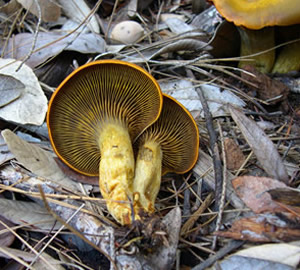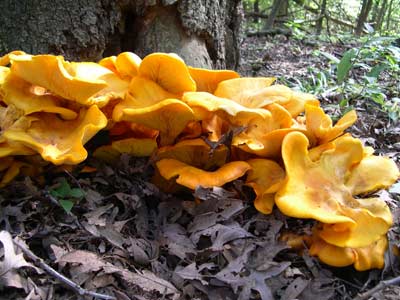Omphalotus olivascens
The “Jack-O-Lantern” Mushroom
It’s October, heading towards November. It’s night. The woods are dark and damp, and the trees creak and sway in the wind. A chill creeps up your spine. Suddenly, your eye is caught by an eerie green glow in the gloom. Is it a spirit? Nope, just a glow in the dark mushroom!

Omphalotus olivascens © photo by Debbie Viess. Note: photographer's arm and hand in lower left.
In January 2013, a very large fruiting of Omphalotus olivascens was spotted on a eucalyptus stump in Huckleberry Botanic Regional Preserve in Oakland. Read "Mystical Glow in a Dark, Dark Woods", posted on the BAMS discussion group.

Omphalotus olivascens - some have zoned gills
© photo by Debbie Viess
The “Jack-O-Lantern” mushroom gets its name not only because it’s orange like a pumpkin, but because, like a pumpkin carved and candled for Halloween, it provides its own light. On the West Coast, Omphalotus olivascens is our most spectacular bioluminescent mushroom. It glows most strongly at the peak of spore production (some claim to be able to read a newspaper by its light), so to view this effect for yourself, you want mushrooms in their prime… not too young, and not too old. You can view it in the field, if you dare, or take it home for a somewhat tamer show. Just bring it (and yourself) into a completely darkened room, or closet, and wait for your eyes to adjust.
Be sure to not confuse it with the edible chanterelle, though, a mushroom that it superficially resembles. The toxins, similar to muscarine, present in a mistaken meal of Omphalotus may produce hallucinations (a plus for some), but will also open you, prodigiously, at both ends, for a not so fun time with fungus. If you plan on hunting mushrooms for the table, it is worth your while to learn the differences between these two mushrooms.
Omphalotus species grow on and break down wood (although the wood may be buried in the ground). Our West Coast version is orange, with a greenish cast to their deep, “true” gills. If you slice them in half, the context, or inner flesh, is also orange. The Midwest and the East Coast have a couple of other species of glow-in-the-dark Omphalotus: illudens and olearius.

Omphalotus illudens - more chanterelle-like than our Western version
© photo by Debbie Viess
Golden chanterelles grow on the ground, and are mycorrhizal. They have shallow gill ridges, not true gills, and these gill ridges are orange (sometimes with a pinkish cast). If you cut these mushrooms in half, their context is white. There are a number of golden chanterelle species here in California, and they are all delicious. In the Chicago area, there is a local species of chanterelle that has a greenish cap, but the gills are never green.
© Debbie Viess

 back to top
back to top